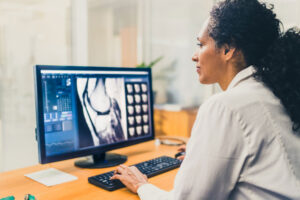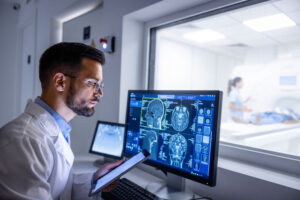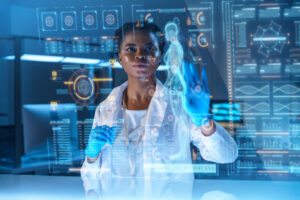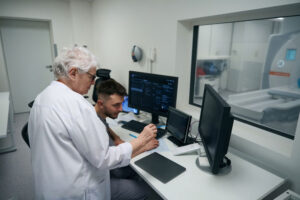Written by Scott Wilson

Artificial intelligence and healthcare have had a close relationship almost from the very beginning. In fact, one of the other industries where you are almost as likely to hear the word “algorithm” as you do in AI is healthcare. Medical professionals have long used basic algorithms as a part of their examination and diagnostic toolkits.
Healthcare algorithms incorporate evidence-based best practices and ensure that clinicians don’t miss a step or overlook the obvious.
Implementing those algorithms in code was an early impulse. MYCIN, an expert system developed in the 1970s, used the technology of the time to diagnose bacterial infection and blood clotting diseases and recommend antibiotics therapies. But it was never widely used, and AI in diagnostics largely fell by the wayside as the field waned.
Now that AI is hot again, healthcare diagnostic and radiological uses are back in the spotlight.



It couldn’t come at a better time.
AI Offers a Lifeline for a Medical Profession Heading for the Brink
 American healthcare in the early 21st century is facing a crisis of epic proportions. The American Medical Association projects a shortage of 100,000 physicians in the system by 2030.
American healthcare in the early 21st century is facing a crisis of epic proportions. The American Medical Association projects a shortage of 100,000 physicians in the system by 2030.
At the same time, American healthcare costs are off the charts. In 2022, according to the Centers for Medicare and Medicaid Services, American healthcare spending hit $4.5 trillion, or 17 percent of total gross domestic product. On a per-person basis, it’s more than twice the cost of other developed economies.
Radiological interpretation has been one of the early wins for machine learning in the healthcare field.
Worse, the spending hasn’t led to better outcomes. And that curve is only likely to increase as fewer providers are available and more expensive treatments are offered to a rapidly aging population.
Artificial intelligence uses in medical diagnostics and radiology may be a ray of light in that dark panorama.
Understanding How Radiology and Medical Diagnostics Work in Healthcare
 Diagnostics and radiology are closely related in most healthcare settings.
Diagnostics and radiology are closely related in most healthcare settings.
Diagnostics are the processes and procedures used by clinicians to develop a medical identification of the sources of injury or disease. They cross a broad spectrum of techniques and technologies, everything from oral patient history assessments to laboratory chemistry to practical physical exams.
Medical imaging has been a big part of diagnostics since the X-ray was first discovered in 1895. The ability to peer inside the body without slicing it open offers a window into potential problems. But it’s a blurry window at best; the penetrating rays and waves used result in images that can only be interpreted by specialists.
Radiology is also the poster child for the dangerous trend of rising costs and greater technical capabilities combined with fewer trained specialists. The growing use of CT (computed tomography) scans has resulted in a wave of data deluging radiologists with too little time to process it all.
Nor is radiology immune to the demographic trends that are driving the need for more tests. The American College of Radiology reported in 2022 that 53 percent of radiologists engaged in active patient care are over the age of 55. As that group retires, the shortage of trained professionals will continue to shrink.
Fortunately, a wave of data is exactly what AI needs to get in the game in diagnostics and medical imaging.
How AI is Revolutionizing Medical Diagnostics and Radiology
 Modern artificial intelligence breakthroughs mostly rely on similar advances in the field of data science. Researchers discovered that machine learning algorithms could best be trained by learning on massive amounts of relevant information. The more data, the more accurate and quicker deep neural networks could become.
Modern artificial intelligence breakthroughs mostly rely on similar advances in the field of data science. Researchers discovered that machine learning algorithms could best be trained by learning on massive amounts of relevant information. The more data, the more accurate and quicker deep neural networks could become.
Artificial intelligence, and image processing in particular, have scored a lot of easy wins in medical imaging for this reason. Even the most elementary uses like cleaning up noisy images or adding colored highlights to aid interpretation are a big boost to accuracy and productivity.
The American College of Radiology has gotten behind AI in a big way. In 2019, it unveiled a free software platform, ACR AI-LAB™, designed to accelerate the adoption and development of AI in the field. Other researchers, working at the University of Washington, are looking at using real-time 3D imagery from inside the vascular system to aid surgeons and hematologists.
AI Diagnostics Uses May Incorporate Both Imagery and Other Data
 There’s far more on the horizon. Deep neural networks, trained on millions of examples of both healthy and diseased patients, may soon spot signs of trouble far faster and more accurately than human radiologists. Already, convolutional neural networks have been showing to have roughly similar abilities in spotting certain cancerous growths in CT scans to human clinicians.
There’s far more on the horizon. Deep neural networks, trained on millions of examples of both healthy and diseased patients, may soon spot signs of trouble far faster and more accurately than human radiologists. Already, convolutional neural networks have been showing to have roughly similar abilities in spotting certain cancerous growths in CT scans to human clinicians.
Imaging isn’t the only use for AI in diagnostics, however.
Human clinicians suffer from human failings when they are taking patient data and trying to correlate it. They get tired, they forget questions, they fail to make relevant associations. With electronic charting and health data collection, they have more to look at than ever.
Just like computer imaging, artificial neural networks can be trained to comb through millions of records of other healthcare data to tease out common statistical threads indicating disease. They may flag risk factors or highlight useful tests long before a clinician’s suspicions would be raised. Or they may serve as a useful double-check on the traditional diagnostic process.
Artificial Intelligence Engineering Jobs in Radiology and Medical Diagnostics
 The healthcare industry is clamoring for AI professionals who can help build just those systems.
The healthcare industry is clamoring for AI professionals who can help build just those systems.
Radiology has been high-tech for quite a while now, with digital imaging long since replacing the old film-based systems. As machine learning starts to bubble up through the industry, many of the existing positions for programmers and analysts in the field will start to take on AI responsibilities, even if the titles don’t change.
Just a few of the job titles you will find working on AI in radiology and diagnostics include:
- AI Programmer
- Machine Learning Researcher
- Radiology Data Annotator
- Postdoctoral Fellow for AI/ML in High-Energy X-Ray Diffraction Microscopy
- AI Data Engineer for X-Ray Imaging
- Senior Image Quality Scientist
These positions run across the spectrum of different kinds of AI career paths. As big projects with significant health, safety, and ethical considerations, they will require everything from AI researchers to AI architects to manage safely.
What Is the Best Education for Getting Into AI in Radiology and Diagnostics?
 As you can imagine with such a confluence of complex fields as medicine and machine learning, AI jobs in radiology and diagnostics require a very specialized kind of training and experience. While you can build your skills with conventional AI and machine learning degrees, a more focused program is almost always the better choice.
As you can imagine with such a confluence of complex fields as medicine and machine learning, AI jobs in radiology and diagnostics require a very specialized kind of training and experience. While you can build your skills with conventional AI and machine learning degrees, a more focused program is almost always the better choice.
There are basically two educational and career paths into these roles:
- Starting off as a healthcare professional and building AI expertise in imaging and data analysis
- Becoming an expert in AI and ML and developing additional understanding of in-depth healthcare diagnostics and imaging
Degrees for Healthcare Professionals Building a Career Using AI in Radiology and Diagnostics
If you’re on that first path, you’re very likely already well along in your training as a medical provider. If that’s the case, you may not want to return to school for a full-on degree program to become an AI expert. In such cases, a certificate program, like an Artificial Intelligence in Healthcare Certificate, is a good option.
For healthcare professionals interested in AI training, there are dual degrees available that combine a Doctor of Medicine with a Master of Science in Artificial Intelligence.
Taking less than a year to complete and offering a focus that builds on your current expertise, these are a fast-track to building your AI skills with a view toward using them in medical imaging or clinical decision support.
In some cases, certificates aimed at medical professionals are even more specific, like those rooted in healthcare informatics, or an AI in Medicine Certificate aimed at bioengineering professionals.
Degrees for Technology Professionals Focused on AI in Radiology and Medical Diagnostics
 The second path is more conventional and runs through degrees like a Master of Applied Artificial Intelligence in Healthcare, or a Master of Science in Artificial Intelligence concentration in Biomedical Engineering. These deliver all the hardcore coding, math, and computer science skills needed by AI engineers, but with additional coursework to aim it at radiology and diagnostics uses.
The second path is more conventional and runs through degrees like a Master of Applied Artificial Intelligence in Healthcare, or a Master of Science in Artificial Intelligence concentration in Biomedical Engineering. These deliver all the hardcore coding, math, and computer science skills needed by AI engineers, but with additional coursework to aim it at radiology and diagnostics uses.
Another good option coming from the tech side is a Master of Science in Imaging Science or Master of Science in Computer Vision. These are specialized subsets of artificial intelligence education that touch on many of the most important needs in radiology.
There aren’t as many certificates aimed at AI professionals looking to shift into healthcare applications later in their careers. Probably the best bet is something like a Graduate Certificate in Healthcare Informatics. Such programs aren’t aimed exclusively at AI but will offer a solid grounding in the types and processes for gathering health data that would be used for AI training and diagnostic uses.
Whatever path you tack into this field, it’s one of the AI applications that will probably see the biggest investment and focus in the first wave of professional AI uses. With the oncoming demographic and professional pressures, clinicians are eager for technology to assist them. With the promise shown even in early research, AI could be a game-changer for both doctors and patients.





